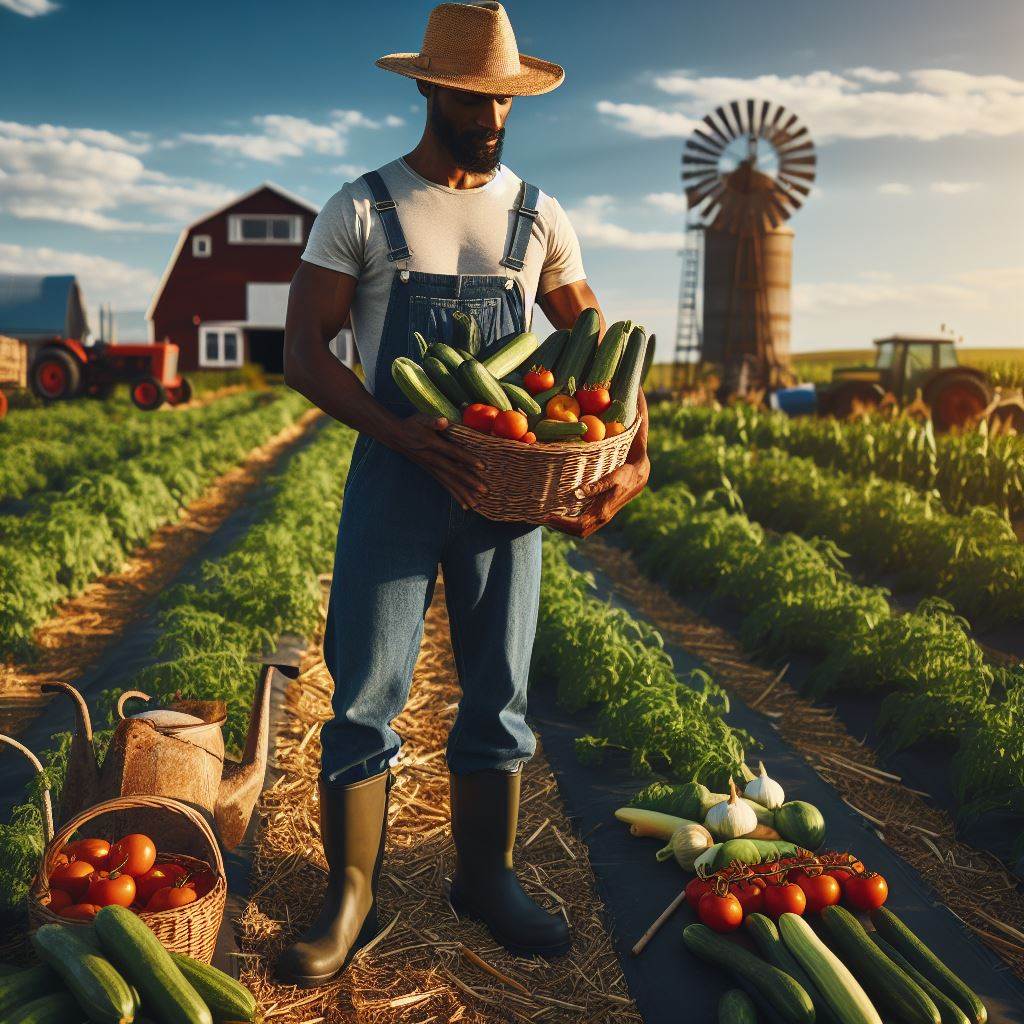Introduction
Background information on food safety technology
In the agriculture industry, ensuring food safety is crucial to protect consumers and maintain trust. The rapid advancements in food safety technology are revolutionizing the way we produce and consume food.
This blog post aims to give an overview of the latest food safety technologies that will shape the industry in 2024.
Importance of Food Safety in the Agriculture Industry
Food safety plays a pivotal role in safeguarding public health and preventing the spread of diseases. With a growing global population, it is vital to ensure that the food supply chain is safe, from farm to fork.
Stakeholders in the agriculture industry understand that investing in new food safety technologies is vital to enhancing consumer confidence and preventing foodborne illnesses.
Purpose of the Blog Post
The purpose of this blog post is to provide readers with a comprehensive overview of the new food safety technologies that will emerge in 2024.
By understanding these advancements, farmers, food manufacturers, and regulatory bodies can stay updated and adopt appropriate strategies to minimize risks and meet evolving safety standards.
This overview will shed light on the promising innovations that will shape the future of food safety and revolutionize the agriculture industry.
In summary, food safety technology is rapidly evolving to address the challenges faced by the agriculture industry.
This blog post will delve into the importance of food safety, highlighting its significance in the industry, and provide readers with an overview of the new technologies that will emerge in 2024.
Stay tuned to explore the cutting-edge solutions that will shape the future of food safety.
Current Challenges in Food Safety
Existing challenges and issues in food safety
Food safety is a crucial issue that affects every individual, as well as the food industry as a whole. However, there are several existing challenges and issues that need to be addressed in order to improve food safety standards. Some of these challenges include:
Lack of traceability
One of the major challenges in food safety is the lack of traceability throughout the supply chain. This makes it difficult to identify the source of contamination during foodborne illness outbreaks.
Inadequate surveillance systems
The current surveillance systems for monitoring food safety are not always effective in detecting outbreaks. This can lead to delays in identifying and addressing potential hazards.
Inconsistent regulations
There is a lack of consistency in food safety regulations across different countries and regions, which can lead to discrepancies in standards and practices.
Increasing globalization
With the increasing globalization of the food industry, there is a higher risk of contaminated products entering the market. This requires stronger international cooperation and coordination in ensuring food safety.
Transform Your Agribusiness
Unlock your farm's potential with expert advice tailored to your needs. Get actionable steps that drive real results.
Get StartedEmerging pathogens
New and emerging pathogens pose a constant threat to food safety. These pathogens may not have been previously identified or may have developed resistance to existing control measures.
Examples of recent outbreaks and recalls
Examples of recent outbreaks and recalls further highlight the importance of addressing these challenges and improving food safety:
E. coli outbreak
In 2018, an E. coli outbreak linked to romaine lettuce resulted in dozens of hospitalizations and multiple deaths. This outbreak emphasized the need for improved traceability and surveillance systems.
Salmonella contamination
In 2019, a widespread salmonella outbreak linked to contaminated eggs led to a large-scale recall. This incident highlighted the importance of consistent regulations and better control measures.
Listeria contamination
In 2020, a listeria outbreak in deli meats resulted in several fatalities. This outbreak demonstrated the need for enhanced monitoring of emerging pathogens and stricter standards in food production.
Need for continuous improvement and innovation in food safety technology
In order to address these challenges and ensure safer food products, continuous improvement and innovation in food safety technology are essential. These advancements can help in:
Improved traceability
New technologies, such as blockchain, can enhance traceability by providing a transparent record of every stage in the supply chain.
Enhanced surveillance
Advanced data analytics and artificial intelligence can be utilized to improve surveillance systems and enable early detection of potential food safety hazards.
Harmonized regulations
International collaboration is crucial in establishing harmonized food safety regulations to ensure consistent standards and practices across borders.
Novel pathogen detection methods
New techniques, such as rapid DNA sequencing, can aid in the early detection and identification of emerging pathogens, facilitating prompt control measures.
Integration of preventive measures
Implementing preventive controls, such as Hazard Analysis and Critical Control Points (HACCP), can help mitigate potential hazards and prevent foodborne illnesses.
In fact, the current challenges in food safety demand immediate attention and continuous improvement.
Examples of recent outbreaks and recalls emphasize the need for innovative solutions and technologies to ensure safer food production and minimize the risks associated with contaminated products.
By addressing these challenges head-on, we can progress towards a safer and more secure food system for all.
Read: 2024 Agri Subsidies: What You Need to Know
Overview of New Food Safety Tech in 2024
The year 2024 has brought about significant advancements in technology within the agriculture industry, particularly in the realm of food safety.
These innovations are revolutionizing the way food safety practices are implemented and enhancing overall consumer protection.
Through automation and data-driven solutions, the food safety landscape has undergone a paradigm shift, ensuring the delivery of safe and high-quality products to consumers.
Advancements in Technology
In recent years, technology has rapidly evolved and greatly impacted various industries, including agriculture. The emergence of new tools, systems, and processes has enabled the enhancement of safety measures in the food production and distribution chain.
Revolutionizing Food Safety Practices
One of the primary benefits of new technology in the field of food safety is its ability to revolutionize current practices.
Through advanced monitoring systems, real-time data analysis, and improved traceability solutions, companies can now detect potential food safety hazards more efficiently.
Furthermore, the use of advanced sensors and IoT (Internet of Things) devices in production facilities allows for continuous monitoring of critical control points.
This proactive approach enables the timely identification of potential issues, reducing the risk of contaminated products reaching consumers.
Automation and Data-Driven Solutions
In the 2024 food safety landscape, automation and data-driven solutions play a crucial role in ensuring effective safety practices.
Showcase Your Farming Business
Publish your professional farming services profile on our blog for a one-time fee of $200 and reach a dedicated audience of farmers and agribusiness owners.
Publish Your ProfileAutomation eliminates human error and enhances the consistency of operations by replacing manual tasks with intelligent machines.
Additionally, the assimilation of various data sources, such as sensor readings, machine learning algorithms, and historical data, enables the development of predictive models for potential contamination scenarios.
This proactive approach empowers companies to take preventive measures before a food safety incident occurs.
Benefits of New Food Safety Tech
The adoption of new food safety technologies in 2024 offers several benefits for both consumers and industry players.
- Enhanced Consumer Protection: With advanced food safety tech, consumers can feel more confident in the safety and quality of the products they consume.
- Improved Efficiency: Automation and data-driven solutions streamline operations, reducing waste and maximizing productivity.
- Cost Savings: By minimizing food safety incidents, companies can avoid costly recalls, legal ramifications, and damage to their reputation.
- Regulatory Compliance: New tech ensures businesses meet and exceed food safety regulations, protecting them from potential penalties.
Challenges and Considerations
While the advancements in food safety technology in 2024 are commendable, there are certain challenges and considerations that need to be addressed.
- Initial Investment: Implementing new technology requires a significant initial investment, which may pose financial challenges for some businesses.
- Integration and Training: Integrating new tech into existing systems and training employees on its proper usage can be time-consuming and complex.
- Cybersecurity Risks: Increased reliance on technology and data sharing exposes businesses to potential cybersecurity threats that could compromise food safety.
- Accessibility and Affordability: Ensuring that smaller farms and businesses have access to affordable food safety tech solutions is crucial for industry-wide improvement.
The year 2024 has witnessed remarkable advancements in food safety technology, transforming the way the agriculture industry ensures the safety and quality of products.
Automation and data-driven solutions have revolutionized practices, improving overall efficiency, consumer protection, and regulatory compliance.
However, challenges surrounding cost, training, cybersecurity, and accessibility must be addressed to ensure widespread adoption and benefit for all stakeholders.
Read: Latest in Farm Policy: 2024’s Big News
Key Trends in Food Safety Technology
Key trends shaping the food safety technology in 2024
Food safety is a critical aspect of the food industry that ensures the protection of consumers from potential hazards related to the consumption of food products.
Advancements in technology have played a significant role in improving food safety standards over the years.
In this blog section, we will identify and explain the key trends shaping food safety technology in 2024, provide use cases and examples to illustrate their implementation, and discuss the potential impact these trends may have on food safety standards.
Use cases and examples to illustrate the implementation of these technologies
Internet of Things (IoT) in Food Safety
The IoT has revolutionized various industries, and the food sector is no exception.
With IoT-enabled sensors, food companies can monitor critical parameters such as temperature and humidity in real-time, ensuring that food products are stored and transported under ideal conditions.
This technology helps prevent spoilage, reduce wastage, and minimize the risk of contamination.
Blockchain for Traceability and Transparency
Blockchain technology provides a decentralized and immutable digital ledger that enables secure and transparent tracking of food products throughout the supply chain.
By recording every transaction, from farm to fork, blockchain ensures traceability and allows quick identification of the source of any contamination or foodborne illness outbreak, facilitating faster recalls and enhancing consumer trust.
Artificial Intelligence (AI) in Food Safety Assessment
AI-powered systems can analyze large amounts of data quickly and accurately, helping in the identification of potential risks and anomalies.
Machine learning algorithms can detect patterns and predict potential contamination sources, enabling proactive measures to be taken to prevent foodborne illnesses.
Robotics and Automation in Food Processing
Automation technologies are becoming increasingly prevalent in food processing facilities. Robots can perform repetitive tasks with precision and consistency, reducing the likelihood of human errors.
Automated systems can also operate in hazardous environments, minimizing the risk of contamination and improving overall food safety.
Advanced Packaging Technologies
Innovative packaging solutions play a vital role in maintaining food safety and extending product shelf life.
Active packaging technologies, such as oxygen scavengers and antimicrobial films, help preserve food quality by preventing spoilage and inhibiting the growth of pathogens.
Additionally, smart labels can provide real-time information on product freshness and integrity.
Rapid Testing and Molecular Diagnostics
Advancements in rapid testing methods and molecular diagnostics have revolutionized food safety analysis.
These techniques enable quick and accurate detection of potential contaminants, allergens, or pathogens, reducing the time required for manual analysis and enhancing overall food safety protocols.
Data Analytics for Risk Assessment
Big data analytics allows the identification of patterns and trends, leading to improved risk assessment models.
By analyzing vast amounts of historical and real-time data, food safety professionals can identify potential risks, make data-driven decisions, and proactively implement preventive measures to mitigate those risks.
Potential impact of these trends on food safety standards
These trends in food safety technology are already making significant headway and will continue to shape the industry in 2024 and beyond.
By implementing these technologies, food companies can enhance their operations, reduce the likelihood of foodborne illnesses, improve traceability, and ultimately build consumer confidence in the safety and quality of their products.
To summarize, the integration of new technologies in the food safety sector is revolutionizing the way companies approach and manage food safety.
IoT, blockchain, AI, robotics, advanced packaging, rapid testing, and data analytics are just a few of the key trends that are set to drive the industry forward in 2024.
Embracing these technological advancements will not only ensure compliance with food safety standards but will also enable companies to gain a competitive edge by prioritizing consumer health and satisfaction.
Read: Farmers & Food Quality: 2024’s Big Changes
BlockChain
Definition and explanation of blockchain technology in food safety
Blockchain technology has emerged as a powerful tool in ensuring food safety across the supply chain.
It is a decentralized, tamper-proof digital ledger that records transactions and exchanges of information in a transparent and secure manner.
Benefits of using blockchain to enhance traceability and transparency
In the context of food safety, blockchain offers several benefits:
- Enhanced Traceability: Blockchain allows for the creation of an immutable record of every transaction and movement of food products from farm to fork. This enables stakeholders to trace the origin, journey, and handling of any food item.
- Increased Transparency: With blockchain, all participants in the supply chain have access to real-time information, ensuring transparency and accountability. This eliminates information asymmetry and reduces the risk of fraud and malpractice.
- Improved Food Safety: By accurately tracking the movement of food products, blockchain helps in identifying and resolving safety issues quickly. It enables swift and targeted recalls, reducing the impact on public health and saving costs for businesses.
There have been several successful implementations of blockchain technology in the agriculture industry, showcasing its potential to revolutionize food safety:
- Walmart and IBM: Walmart partnered with IBM to develop a blockchain-based system for tracking the origin and movement of pork products in China. This improved transparency and traceability, enabling Walmart to address food safety concerns effectively.
- Frank Yiannas and the FDA: Frank Yiannas, former Vice President of Food Safety at Walmart, joined the FDA and advocated for the use of blockchain in food safety. The FDA piloted a blockchain system to track the supply chain of lettuce and successfully traced the source of a foodborne illness outbreak.
- FarmShare: FarmShare is a startup that utilizes blockchain technology to ensure the quality and safety of organic produce. Their platform enables consumers to access information about the farms, production practices, and certifications of the products they purchase.
Case studies showcasing successful implementation of blockchain in the agriculture industry
These case studies highlight the effectiveness of blockchain in enhancing food safety by providing a transparent and secure system for tracking and managing the supply chain.
However, it is important to acknowledge the challenges and limitations of blockchain technology:
Showcase Your Farming Business
Publish your professional farming services profile on our blog for a one-time fee of $200 and reach a dedicated audience of farmers and agribusiness owners.
Publish Your Profile- Integration: Integrating existing systems and legacy data onto the blockchain can be complex and time-consuming.
- Costs: Implementing blockchain technology requires significant investment in infrastructure and training.
- Standardization: Establishing industry-wide standards for blockchain implementation is critical to ensure interoperability and maximize its potential.
- Privacy: Protecting sensitive information while maintaining transparency is a challenge that needs to be addressed.
- Adoption: Encouraging widespread adoption of blockchain technology across the industry is crucial for its success.
Therefore, blockchain technology holds immense promise in revolutionizing food safety by enhancing traceability and transparency.
Its successful implementation in the agriculture industry has demonstrated its effectiveness in mitigating risks and ensuring consumer confidence.
However, addressing the challenges and limitations associated with blockchain is essential for its widespread adoption and long-term success.
As we move towards 2024 and beyond, blockchain will continue to play a pivotal role in shaping the future of food safety.
Read: Navigating Food Safety Laws in 2024

Internet of Things (IoT)
IoT and its application in food safety
Internet of Things (IoT) is a term used to describe the connection of everyday objects to the internet.
In the context of food safety, IoT technology has the potential to revolutionize the way we monitor and control food safety parameters.
IoT devices can be embedded in various food processing and storage equipment to monitor critical parameters.
These devices can collect data on temperature, humidity, contamination levels, and other important factors.
By continuously monitoring these parameters, IoT devices can provide real-time alerts and notifications to prevent potential contamination.
For example, in a food processing plant, IoT sensors can monitor the temperature of refrigerators and freezers.
If the temperature exceeds the safe range, the system can send an immediate alert to the operator, preventing the spoilage of food.
How IoT devices can monitor and control food safety parameters
IoT devices can also help prevent contamination by monitoring environmental factors that may promote the growth of bacteria or pathogens.
These devices can measure humidity levels, air quality, and even detect the presence of airborne contaminants.
By analyzing this data, operators can take corrective actions to maintain a safe and hygienic environment.
Case studies demonstrating the effectiveness of IoT solutions in preventing contamination
Several case studies have demonstrated the effectiveness of IoT solutions in preventing contamination in the food industry.
For instance, a study conducted in a dairy processing plant showed that IoT sensors installed in milk tanks were able to detect abnormal temperatures.
These sensors triggered an immediate alert, allowing the operators to take corrective actions and prevent the spoilage of milk.
In another case, IoT devices installed in a restaurant’s kitchen were able to monitor the temperature of refrigerators and food storage units.
By continuously monitoring the temperature, the system detected a malfunctioning refrigerator and alerted the staff to transfer the contents to a working unit.
This prevented the spoilage of food and potential health risks to customers.
Overall, IoT technology has the potential to greatly enhance food safety by providing real-time monitoring and control.
By leveraging IoT devices, the food industry can proactively prevent contamination, reduce waste, and improve overall quality.
However, it is important to note that the successful implementation of IoT solutions requires a robust infrastructure and proper data analysis.
Operators must be able to interpret and respond to the data generated by IoT devices in a timely manner.
Generally, IoT technology offers a promising solution for improving food safety.
By leveraging the capabilities of IoT devices to monitor critical parameters, the food industry can prevent contamination and ensure the delivery of safe and high-quality products.
The successful implementation of IoT solutions requires a collaborative effort among industry stakeholders to build the necessary infrastructure and expertise.
Artificial Intelligence (AI)
Artificial Intelligence (AI) is revolutionizing the field of food safety. With its ability to analyze vast amounts of data and detect patterns, AI is playing a crucial role in ensuring food safety standards are met.
By leveraging AI technology, predictive and preventive measures in the food industry are being greatly enhanced.
Introduction to AI and its Role in Food Safety
AI refers to the simulation of human intelligence in machines programmed to think and learn like humans.
In the context of food safety, AI can analyze data collected from various sources such as sensors, cameras, and databases to identify potential risks and prevent foodborne illnesses.
Traditionally, food safety measures relied on manual inspections and quality control processes, which were time-consuming and prone to human error.
AI, on the other hand, offers real-time monitoring and data analysis, significantly improving the efficiency and effectiveness of food safety protocols.
How AI can Improve Predictive and Preventive Measures in Food Safety
AI is capable of analyzing vast amounts of data, including temperature records, supply chain information, and customer feedback, to identify potential risks and predict outbreaks before they occur.
This enables proactive interventions to prevent contamination and the spread of foodborne diseases.
AI-powered predictive models can continuously adapt and learn from new data, becoming increasingly accurate in detecting potential risks.
By leveraging machine learning algorithms, AI systems can identify patterns and anomalies that may go unnoticed by human inspectors.
Furthermore, AI streamlines food safety processes by automating routine tasks such as monitoring temperature, inventory management, and quality control.
This reduces the reliance on manual labor and minimizes the chances of errors or oversights.
Showcase Your Farming Business
Publish your professional farming services profile on our blog for a one-time fee of $200 and reach a dedicated audience of farmers and agribusiness owners.
Publish Your ProfileExamples of AI-powered Systems Used to Detect and Manage Food Safety Risks
- Food Contamination Detection: AI can analyze data from sensors and cameras to detect contaminants in food products. For example, machine vision systems can identify foreign objects, such as metal or glass, in real-time during production.
- Predictive Analytics for Outbreaks: AI algorithms can analyze historical data on foodborne illnesses, weather conditions, and other relevant factors to predict the likelihood of outbreaks. This enables authorities to take proactive measures to prevent widespread contamination.
- Supply Chain Monitoring: AI-powered systems can track and analyze data throughout the entire supply chain, from farm to fork. This ensures compliance with safety regulations, traceability of ingredients, and prompt identification of potential risks.
- Quality Control Automation: AI can automate quality control processes by analyzing sensory data, such as taste, texture, and aroma, to ensure consistent quality in food products. This reduces the reliance on subjective human evaluations.
In essence, AI is revolutionizing food safety by improving predictive and preventive measures. With its ability to analyze extensive data, AI systems are enhancing the detection and management of food safety risks.
By leveraging AI technology, the food industry can ensure safer products and protect consumers from foodborne illnesses.
Robotics and Automation
In the 21st century, technology has made significant advancements in various industries, including food safety.
One of the most intriguing developments is the integration of robotics and automation technologies to enhance food processing and inspection.
These cutting-edge solutions offer numerous advantages and have the potential to revolutionize the industry.
Overview of Robotics and Automation Technologies in Food Safety:
Robotic systems and automation technologies are being increasingly employed in various stages of the food supply chain, from farming and harvesting to processing and packaging.
These technologies encompass a wide range of applications, such as robotic arms, automated sorting systems, and sensor-equipped machinery.
Robotic arms are often used for handling and processing delicate food items. With their precision and dexterity, they can perform tasks such as cutting, slicing, and packaging with utmost accuracy.
Automated sorting systems, on the other hand, use advanced algorithms and cameras to categorize and separate food products based on predetermined criteria.
Sensor-equipped machinery plays a crucial role in ensuring food safety by continuously monitoring and controlling critical parameters.
For instance, temperature sensors can detect any variations that could lead to spoilage, while moisture sensors can help maintain optimal moisture levels during processing.
Advantages of Using Robots for Food Processing and Inspection
The integration of robotics and automation in the food industry offers numerous advantages that contribute to improved safety, quality, and efficiency. Here are some key benefits:
- Enhanced Food Safety: Robots can minimize the risk of food contamination by minimizing human contact, which is one of the main sources of contamination. They can ensure that food is handled and processed in a hygienic and controlled environment.
- Improved Efficiency: Robotic systems can significantly accelerate food processing and inspection tasks. With their speed and precision, they can increase production rates while maintaining consistent quality.
- Reduced Labor Costs: Automation technologies can reduce reliance on manual labor, leading to cost savings for food producers. This is particularly beneficial in industries with labor shortages or high labor costs.
- Minimized Human Errors: Human errors can have severe consequences in food processing and inspection. By replacing manual tasks with robotic systems, the margin for human error is greatly reduced, enhancing overall product quality and safety.
- Real-time Data Collection: Robotics and automation technologies can collect real-time data on various parameters, such as temperature, moisture, and product quality. This data can be analyzed and used to make informed decisions for process optimization and quality control.
Case Studies Showcasing the Use of Automation in Reducing Human Errors and Improving Efficiency
Several case studies have demonstrated the effectiveness of robotics and automation in food safety. One notable example is the use of robotic arms in the slicing and packaging of meat products.
A large meat processing company implemented robotic systems to handle the delicate task of slicing and packaging different cuts of meat.
The robots, programmed with precise cutting techniques, achieved consistent slice thickness and packaging accuracy, reducing product variation and waste.
In another case, an automated sorting system was employed by a fruit and vegetable producer to separate high-quality produce from those with defects.
The system utilized computer vision and machine learning algorithms to identify and sort fruits and vegetables based on color, size, and texture.
This not only improved efficiency but also minimized the chances of defective products reaching the market.
These case studies highlight the potential of robotics and automation in addressing challenges in food safety, including reducing human errors, maintaining quality standards, and improving overall efficiency.
Essentially, the integration of robotics and automation technologies in food safety is a game-changer for the industry.
The advantages offered by these technologies, such as enhanced food safety, improved efficiency, and reduced human errors, are invaluable.
As technology continues to advance, we can expect further developments and innovations that will continue to raise the bar in food safety standards.
Potential Benefits and Challenges
Summary of the potential benefits of adopting new food safety tech in 2024
Adopting new food safety tech in 2024 can offer numerous potential benefits to the industry.
Improved traceability is a key advantage of these technologies, allowing faster identification and recall of contaminated products.
Efficient data collection and analysis can lead to better identification of potential hazards and proactive preventive measures.
Automated monitoring systems can significantly reduce the risk of human error, enhancing food safety protocols.
Real-time monitoring of temperature, humidity, and other factors can ensure optimal storage conditions and reduce spoilage.
Enhanced communication and collaboration between various stakeholders can improve overall food safety compliance.
Streamlined documentation processes can reduce administrative burden and increase operational efficiency.
Implementing new tech can also provide a competitive advantage by meeting consumer demand for safer food products.
Challenges and limitations associated with implementing these technologies
However, there are several challenges and limitations associated with implementing these technologies:
High upfront costs can be a major obstacle for small and medium-sized businesses.
Complexity and compatibility issues between different systems may hinder smooth integration.
Technological infrastructure and connectivity issues in certain regions can limit widespread adoption.
Resistance to change and lack of awareness among industry stakeholders can slow down the transition.
Cybersecurity risks need to be addressed to ensure data integrity and safeguard against potential breaches.
Regulatory frameworks may need to be updated to accommodate the use of new technology in food safety.
Effective training and education programs should be implemented to ensure proper utilization of the technology.
The need for ongoing maintenance and updates can incur additional costs and demands on resources.
Need for industry-wide collaboration and support to overcome challenges
Overcoming these challenges requires industry-wide collaboration, support, and cooperation:
Showcase Your Farming Business
Publish your professional farming services profile on our blog for a one-time fee of $200 and reach a dedicated audience of farmers and agribusiness owners.
Publish Your ProfilePublic-private partnerships can facilitate knowledge sharing and resource pooling to drive technology adoption.
Government agencies should provide incentives, grants, or subsidies to offset initial costs and encourage adoption.
Standardization efforts can help address compatibility issues and ensure interoperability of different systems.
Industry associations can play a crucial role in promoting awareness, education, and training initiatives.
Cross-sector collaboration between food producers, manufacturers, suppliers, and regulators is essential.
Investing in research and development can further enhance the effectiveness and affordability of food safety tech.
In general, adopting new food safety tech in 2024 offers significant potential benefits for the industry.
However, challenges related to cost, compatibility, awareness, and security must be addressed through collaboration and support.
By working together, stakeholders can overcome these barriers and create a safer and more resilient food system.
Conclusion
Recap of the importance of food safety technology
In the end, food safety technology plays a crucial role in ensuring the safety and quality of our food supply. The advancements made in this field are significant and must be embraced for a safer food supply chain.
Throughout this blog section, we have discussed various new food safety technologies that are set to revolutionize the industry in 2024.
From blockchain to AI and IoT, these technologies offer improved traceability, efficiency, and accuracy in food safety practices.
Emphasis on the significance of adopting new tech for a safer food supply chain
It is essential to recognize the importance of adopting these new technologies. By doing so, we can minimize the risks of foodborne illnesses, contamination, and recalls.
The implementation of innovative solutions will enable us to better safeguard public health and enhance consumer confidence in the food industry.
Encourage readers to explore and embrace the advancements in food safety tech in 2024
We encourage our readers to explore and embrace the advancements in food safety technology in 2024.
This means staying up-to-date with the latest developments, attending industry conferences and workshops, and actively seeking out opportunities to implement these new technologies in our food production and distribution systems.
As individuals, we can also play a part by supporting companies and organizations that prioritize food safety and invest in new technology.
By choosing brands that prioritize safety and quality, we can collectively contribute to a safer and more reliable food supply chain.
All in all, the future of food safety lies in the effective adoption of new technologies. Let us embrace these advancements and work towards a safer and more secure food system for all.




